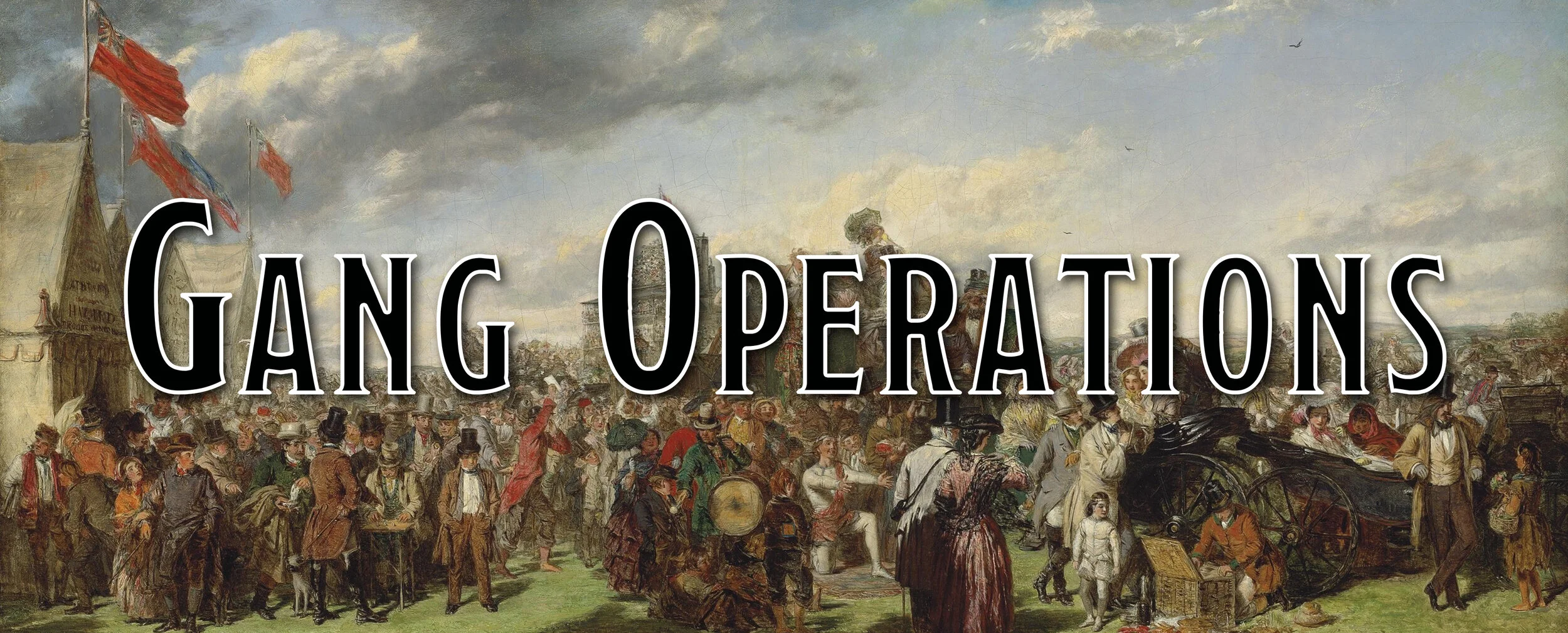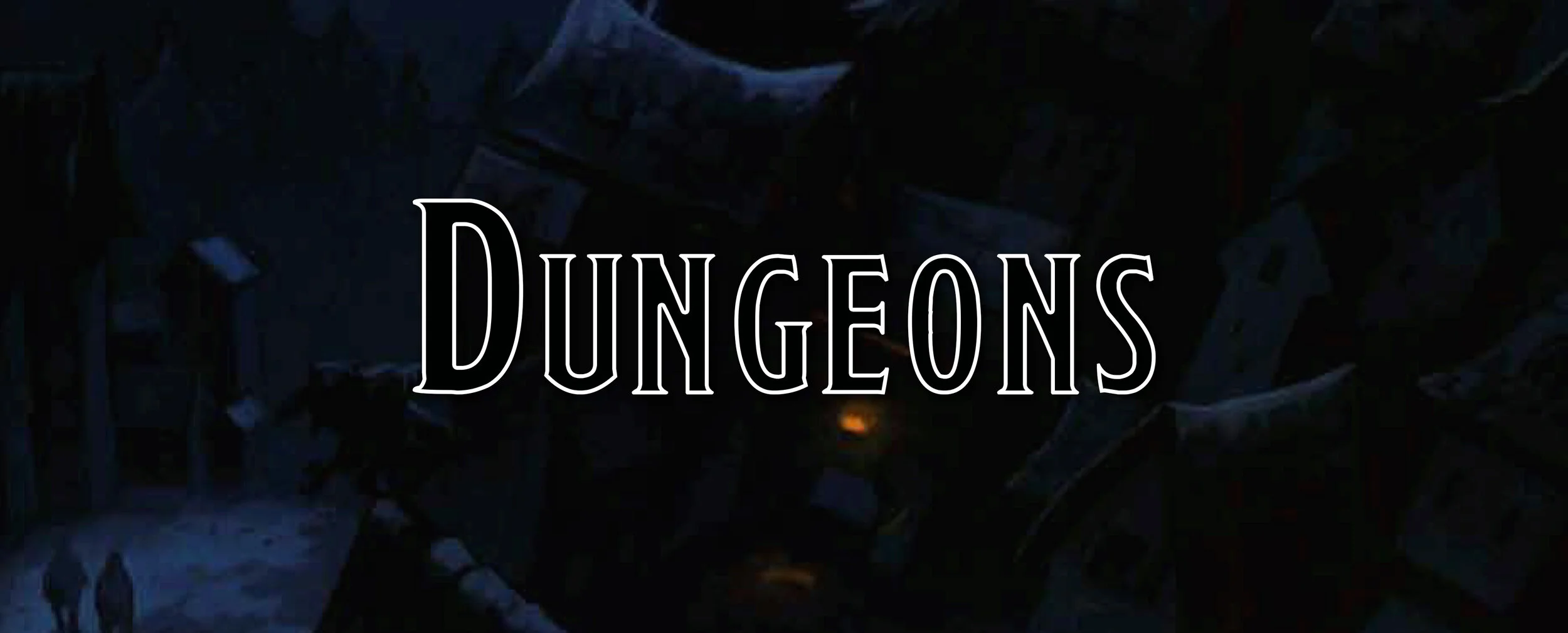Gang Operations - Homebrew
Header Art: Derby Day by William Powell Frith
This week’s post is on a system for running a gang from our newest adventure we just released - Trouble In Lower Bern - the first part of a three-part adventure where a party of adventurers start a gang and bring down the tyrannical Bloodied Hand. This system is meant to abstract out the minutiae of running a gang for something much faster that can go as deep or as shallow as you’d like. It even includes rules for a gang fight so if you want to live out your dreams of Assassin’s Creed - Syndicate it has your back!
For those that don’t care about the nitty-gritty:
For best results in GM Binder, use a Chrome Browser
Gang Operations
The goal of this system is to simplify a complex organization while still allowing players a lot of say over how their gang functions. In addition, as the players level up, so too should their gang so as the party gets stronger, their gang does as well.
To accomplish this, gangs are given a focus which is basically just a class that the gang takes. To increase their level in their focus, they have to recruit new members which are the experience points for the gang, and each recruit counts as their hit points. This means that players should be focused on growing the size of their gang as it not only increases their hit points but also increases their gang’s survivability.
In addition to simply having a larger gang, the party gets another benefit from running an organization. Each week they can decide on tasks for their gang to accomplish, known as the Gang Activity where the gang can make money, skirmish with other gangs, recruit new members, sabotage their enemies, or any activities that players and GMs can come up with.
Gang Focus
This system provides three focuses, or classes, that a gang can take: Brute, Spy, and Thief.
Brutes are the bruisers and thugs who excel at dealing damage and getting hit, they are a force to be reckoned with during a gang fight.
Spies deal with subterfuge and sabotage, providing information to the party and helping them plan for anything that might come up.
Thieves are focused on the culmination of wealth and gang activities.
Gang Level
A gang’s level is tied directly to how many members it has, not including the party. To figure out how many members a gang need is based on the same experience points that a player needs for each level except it is only 1% of that number. This means that at Lv-2, a gang needs 9 members to reach Lv-3 (while a player needs 900 XP). To become an Lv-10 gang, they’ll need 640 members, and to reach Lv-20 they’ll need 3,550 members.
Since their level is tied to how many members are in the gang, it can be dangerous to lose too many members since if they lose members, they might a gang level. If they have 650 members and are dealt 20 damage, that would decrease their membership to 630, meaning that they fall below Lv-10 and are back down to Lv-9.
Recruits are the experience points and hit points of the gang, the more the party recruits, the stronger and bigger their gang gets.
Ability Dice
Unlike a player character or a monster, gangs are not given ability scores but rather ability dice. There are only three abilities: Physical, Intellect, and Guile. Each focus has the main ability that they are good at, like Brutes have Physical, which means that they start out with a bigger sized die and it increases at a faster rate than for the other abilities.
Since Brutes are focused on Physical, they start with a d6 in that ability and a d4 in Intellect and Guile. As they level up, their Physical die increases to a d8, d10, and to a d12 at the highest levels. Their Intellect and Guile also increase, but much slower and go from a d4 to a d6 and then a d8. So while their secondary abilities get better as they get stronger, they won’t ever be as good as a gang that uses those abilities as their primary.
Spies’ main ability is their Intellect while Thieves’ main ability is their Guile.
DC
Since the gangs are only rolling d4s to d12s, the DCs they are trying to hit is much smaller than what the player characters are typically used to. An Easy DC is 2, meaning that if you have a d4, you’ll only fail 25% of the time. It increases in difficulty to 3, 5, 7, and 11 - though the DM is free to make up their own DCs based on what the party/gang is trying to accomplish.
This also means that a gang whose secondary focus is on Guile and they are trying to use Guile to accomplish something are not going to be able to hit higher DCs until they can level up or they get a captain to give them bonuses to their roll.
Treasure Dice
Another abstraction within the gang is Treasure Dice. These dice are simply used as tokens to measure the wealth of the gang and what the gang/party can do with them. The smallest-sized die is a 1d4 Treasure Dice, which is roughly valued at 100 gp. It increases from there to a 1d6, 1d8, 1d10, and a 1d12 Treasure Dice, though they aren’t just simply worth a bit more money but worth a lot more money.
To create a 1d6 Treasure Dice, it requires 4d4 Treasure Dice, and to create a 1d8 Treasure Dice it requires 6d6 Treasure Dice. So to increase in size for your Treasure Dice, it requires accumulating enough of the lower sized Treasure Dice equal to the die number associated with it. This means that a 1d12 Treasure Dice is made up of 1,920d4 Treasure Dice or roughly about 192,000 gp.
The gold reference value is only to help as a way to realize how valuable the dice are, and that larger dice are worth thousands of gold pieces.
Captains
Gangs need leadership to guide them, and while the party is assumed to be the leaders, they need managers below them. Captains help guide a gang’s focus and provide bonuses to certain things that a party might want to accomplish. Captains are important because they grant bonuses to checks being rolled, making it more likely that a gang can accomplish certain tasks or that they can take on tasks they weren’t able to do previously.
Activities
Every week, the party must decide on what their gang is working towards. This could be recruiting new members, looking for specific magic items, intimidating new members into joining, or taking part in a border war with rival gangs.
A few options are provided, but they aren’t the only options that a gang could be working on. In addition, each of the provided options has multiple DCs associated with them so that as your gang gets stronger, they can accomplish more and more.
End of Week
This then brings us to the End of Week rolls. After every week, the party must roll to see if they got new members in their gang, or potentially lost members due to being attacked, arrested by the guards, or simply decided that working for the party isn’t as lucrative as they would’ve liked. It is favored towards the party increasing their membership, so if you rolled each number over the course of 20 weeks, you’d end up with more recruits than you lost.
After you roll for membership, there are also random events that can take place. They range from your own gang stealing from you and running off with your treasure, to taking on jobs and getting paid.
Gang Fight
Gangs often don’t get along with other gangs, for some odd reason. When it comes time to fight, I wanted to create something that could be handled in just a few minutes without taking too much focus away from the party. When two gangs fight, they each take their action at the very top of the round and are given dice to decide what to do with.
The number of dice given are based on their Proficiency Bonus and are the same size as their Physical dice. So if they are a lv-4 Brutes, they’d have a 2d6 dice that they can use to Attack, Defend, or Assist their leaders. Attacking means that they are looking to deal damage, Defending reduces oncoming damage, and Assisting grants their leaders a bonus to a d20 roll of their choice.
Each gang is given these dice and they assign them in secret. Once both sides have assigned them, they then reveal what they decided to do with them and dice are rolled.
To Attack, the party rolls the number of dice they allocated to Attacking and then they multiply that value by half their level, rounded down. So for our Lv-4 Brutes, if they assigned one of their D6s to this, they would roll the dice and then multiply by it 2 to determine how much damage they dealt.
If their rivals assigned a 1d4 to Defend, they would roll the 1d4 and then also multiply that value by half their level. They would then reduce the amount of damage they take by that multiplied value.
After that, if the gang assigned any of their dice to their leaders, then one leader per dice gets to add the dice to one of their d20 rolls - similar to a bard’s inspiration. The Assisting mechanic could be that the gang throws a brick at the leaders that the party is fighting, distracting them so that the party can hit on that attack, or maybe they shout a word of warning when the party is about to make a saving throw.
Once Attack, Defend, and Assisting is resolved, it then goes into the normal battle where the party faces off against the leaders of the gang they are fighting. Once everyone goes, it then goes to the top of the next round where the gangs repeat their allocation of dice and, once the gangs attack and defend, it goes on to the players who continue their fight. This goes on until the leaders are defeated or one of the gangs are reduced to 0 hit points or 0 members left standing.
Trouble In Lower Bern
That is the basics of Gang Operations, if you are interested in seeing more about this system make sure you check out the links above to look over the rules. If you are curious to see how these rules are used in an adventure, check out our latest adventure Trouble in Lower Bern. It is the first part in a three-part series that follows the exploits of a party who start up a gang in a massive city with the purpose of bringing down the Bloodied Hand, a violent and powerful gang that controls much of the illegal activity in the city.
If you want a printer-friendly PDF of this homebrew, or any other homebrew I’ve created, join us on Patreon! All homebrew, including tools, that I’ve created or will create in the future will be uploaded to our Patreon in printer-friendly versions. We appreciate any and all support!
Like what we are doing here?
Support us on Patreon!
You’ll get early access to deep dives, our Homebrew Hoard, Monster Thursdays, and more!
Follow us on Twitter to keep up to date on everything we talk about!



